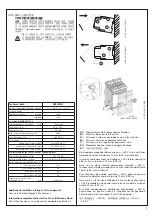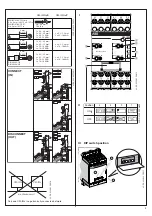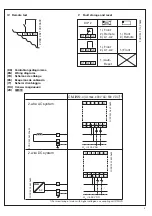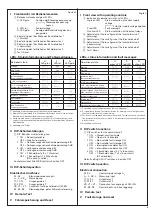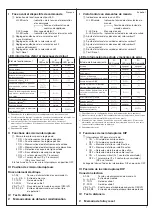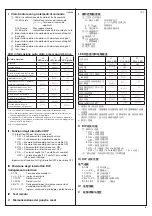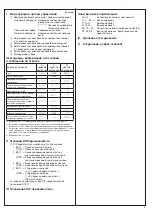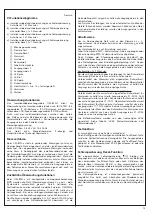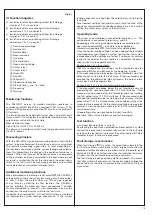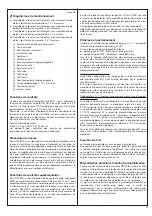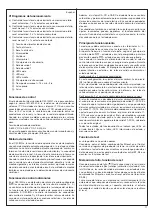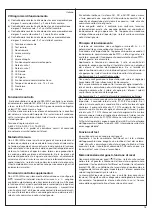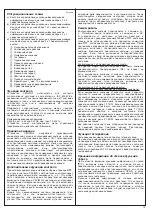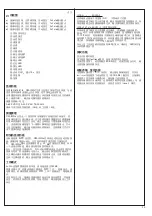
15
leakage capacitance is too high, the output relays switch to the
fault state.
Also incorrect settings that could cause a faulty function of the
device are monitored. When the device detects such an incorrect
setting, the output relays switch to the fault state.
Operating mode
The system to be monitored is connected to terminals L+, L- . The
earth potential is connected to terminals
w
and KE.
Depending on the setting, the device operates according to the
open-circuit principle
h
– fault state: relay energized or
closed-circuit principle
g
– fault state: relay de-energized
Once the control supply voltage has been applied the insulation
monitoring relay runs through a system test routine. The system
is diagnosed and the settings are tested. If no internal or external
faults are found after this test routine is completed, the output
relays switch into the operational state.
Configuration 1 x 2 c/o contacts:
With this configuration the settings for the threshold value for
prewarning (R2) have no influence on the operating function.
If the measured value drops below the set threshold value, the
output relays switch into the fault state. If the measured value
exceeds the threshold value plus hysteresis, the output relays
switch back into their original state.
Configuration 2 x 1 c/o contact (prewarning and warning):
If the measured value drops below the set threshold value for
prewarning the second output relay 21-22/24 switches. If the
measured value drops below the threshold value for warning,
the first output relay 11-12/14 switches. If the measured value
exceeds the threshold value for warning plus hysteresis, the first
output relay 11-12/14 switches back into its original state. If the
measured value exceeds the threshold value for prewarning plus
hysteresis, also the second output relay 21-22/24 switches back
to its original state.
All operating states are signalled by the front-face LEDs.
See table „LEDs, status information and fault messages“
Test function
is only possible when there is no fault.
By pressing the front-face combined test/reset button a system
test routine is executed. The output relays switch to the fault state
as long as the test button is pressed, the control contact S1-S3 is
closed or the test functions are processed.
Fault storage, reset function
When fault storage (
f
) is active, the output relays remain in the
fault state and only switch back to their original state after the
combined test/reset button is pressed or after the remote reset
(terminals S2-S3) is activated, and when the insulation resistance
is higher than the set threshold value(s) plus hysteresis.
The fault storage is designed non-volatile (remanent). This means
that after switch-off and return of the control supply voltage the
device returns to the state it was prior to the switch-off until a reset
is executed.
English
VI Function diagrams
a) Insulation resistance monitoring without fault storage,
auto reset, 1 x 2 c/o contacts
b) Insulation resistance monitoring with fault storage,
manual reset, 1 x 2 c/o contacts
c) Insulation resistance monitoring without fault storage,
auto reset, 2 x 1 c/o contact
d) Insulation resistance monitoring with fault storage,
manual reset, 2 x 1 c/o contact
햲
Control supply voltage
햳
Remote Test
햴
Remote Reset
햵
Measured value
햶
Hysteresis
햷
Threshold value
햸
Open-circuit principle
햹
Output relay 1
햺
Output relay 2
햻
Green LED
햽
Red LED
햾
Yellow LED
햿
Closed-circuit principle
헀
Start-up time t
s
, min. 15 s, fixed
헁
Prewarning
헂
Warning
Monitoring functions
The CM-IWN.1 serves to monitor insulation resistance in
accordance with IEC 61557-8 in unearthed IT AC systems, IT AC
systems with galvanically connected DC circuits, or unearthed IT
DC systems.
The insulation resistance between system lines and system earth
is measured. If this falls below the adjustable threshold values, the
output relays switch into the fault state.
Measured input voltage:
0-600 V DC or 0-400 V AC, 15-400 Hz
The device can monitor control circuits (single-phase) and main
circuits (3-phase).
Measuring principle
With the CM-IWN.x a pulsating measuring signal is fed into the
system to be monitored and the insulation resistance calculated.
This pulsating measuring signal alters its form depending on
the insulation resistance and the system leakage capacitance.
From this altered form the change in the insulation resistance is
forecast. When the forecast insulation resistance corresponds
to the insulation resistance calculated in the next measurement
cycle and is smaller than the set threshold value, the output relays
switch to the fault state. This measuring principle is also suitable
for the detection of symmetrical insulation faults.
Additional monitoring functions
When interrupted wire detection is activated
u
, the CM-IWN.x
automatically controls the system /measuring circuit connections
L+ and L- when the system starts up. This can be repeated
at any time by activating the test function. The CM-IWN.x
cyclicly monitors the measuring circuit connections
w
and KE
for wire interruption. In case of a wire interruption in one of the
connections, the output relays switch to the fault state.
In addition, the unearthed AC-, DC- or AC/DC system is monitored
for inadmissible system leakage capacitance. If the system


